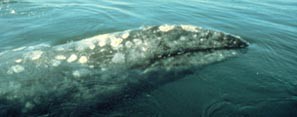|
Dear Friend,
The California Gray Whales need immediate help, and there are three things you can do:
1) Donate money towards implementing a temporary injunction to stop an experiment that will expose up to 3,000 migrating Gray Whales---more than 20 percent of the total number---to very loud sounds.
The experiment is to be conducted by Dr. Peter Tyack on behalf of the U.S. Navy, and is scheduled to begin on this coming January 8th 2003. Approximately U.S. $6,000.00 more is needed. Checks should be made payable to Sea Sanctuary, Inc. and mailed to them at 408 Upton Street, Redwood City, CA 95062.
Mark the check or money order as for `Tyack lawsuit fund'. (DETAILS of the experiment and the dangers it poses are given BELOW.)
2) FAX letters expressing your concerns to William Hogarth, Director, NMFS, fax No: (301) 713-1940 and Peter Douglas, Executive Director, California Coastal Commission, Fax No: (415) 904-5400.
If you are a US citizen, you should also contact your elected government representatives and members of the Senate Environment Committee, and the House Sciences and Resources Committees, and let them know of your concerns regarding this experiment and ask them to do all they can to safeguard these jeopardized whales and initiate an injury into the matter.
http://www.congress.org
is an easy web site to contact your elected officials through, and
http://www.congress.org/Congressorg/dbq/officials/directory/directory.dbq?Command=congdir
is any easy way to contact Committee Members through.
3)PASS the word to others who might be concerned about the survival of these Gray Whales!
The EXPERIMENT and ITS HAZARDS:
Tyack will expose the whales to low (766--965 Hz, or cycles per second) and high frequency (10,000 Hz or above) sounds AT HIGH SOUND LEVELS, up to 180 dB according to Dr. Tyack------256 times more loud than the level that causes pain in humans. The animals will have a receiving device temporarily attached to them by suction cups to receive and record the sound data and record the whales' responses to the sounds.
The National Marine and Fisheries Service (NMFS), which has the duty to enforce the Marine Mammal Protection Act (MMPA), concluded that no Environmental Assessment would be necessary to review Tyack's request to conduct the experiment and granted the `take permit' necessary under the MMPA for him to do so.
However, the number of Gray Whales has been declining worldwide, and here's what renowned expert Dr. Lindy Weilgart had to say about migrating whales in Dick Russell's `Eye of the Whale':
"Anything that has the potential to change, even slightly, a whole population of migrating whales should be viewed with extreme caution. If something serious befalls these migrating animals, it means that the whole population is doomed."
In fact, the U.S. Delegation to the IWC meeting in Japan gave evidence that the Gray Whale population had declined by 9,000, that calf number were down by 80 percent (in 2000) and that the latest estimates showed that there was NO recovery in calves and the number of adults continued to decline.
How all this came about was that Tyack's original request was for sound levels of 140 dB, which was granted. He later filed an amended request for sound levels of 160 dB, and this was granted as well. Later still, he filed a further amended request to use sound levels of 180 dB, and this---the current permit---was granted. In view of the information in the preceding and following paragraphs, issuing the amended permits---especially the last for 180 dB---without an environmental assessment was particularly foolhardy.
Sounds at levels 322 times LOWER (155 dB) from U.S. Navy SONARs caused the deaths of multiple beaked whales in the Bahamas during March of 2000; sounds at levels 1048,576 times lower (120 dB) are known to have caused behavioral changes in the whales and can interfere with their ability to communicate, and this is especially true for mother/calf communications. The effect of sound on whales fetuses and newborn calves is unknown, and since the whales will be returning from their breeding grounds, the experiment presents grave risk to future whale populations. However, it's clear from the experiment methodology description that the sound levels they may be exposed to could be considerably higher!
If you can, I urge you to send a donation, contact the NMFS and CCC, and pass the word as I have, and am, doing.
Thank you for your consideration.
William Wilgus
Director@ThePublicCause.Net
http://www.thepubliccause.net
|
